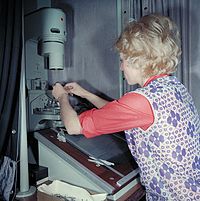
Photo from wikipedia
A method for quantification of plasmon mode quality factors using a novel collinear single-beam interferometric nonlinear optical (INLO) microscope is described. A collinear sequence of phase-stabilized femtosecond laser pulses generated… Click to show full abstract
A method for quantification of plasmon mode quality factors using a novel collinear single-beam interferometric nonlinear optical (INLO) microscope is described. A collinear sequence of phase-stabilized femtosecond laser pulses generated by a series of birefringent optics is used for the INLO experiments. Our experimental designs allow for the creation of pulse replicas (800 nm carrier wave) that exhibit interpulse phase stability of 33 mrad (approximately 14 attoseonds), which can be incrementally temporally delayed from attosecond to picosecond time scales. This temporal tuning range allows for resonant electronic Fourier spectroscopy of plasmonic gold nanoparticles. The collinear geometry of the pulse pair facilitates integration into an optical microscopy platform capable of single-nanoparticle sensitivity. Analysis of the Fourier spectra in the frequency domain yields the sample plasmon resonant response and homogeneous line width; the latter provided quantification of the plasmon mode quality factor. We have applied this INLO approach to quantitatively determine the influence of encapsulation of gold nanorods with silica shells on plasmon quality factors. We have studied a series of three gold nanorod samples, distinguished by surface passivation. These include cetyltrimethylammonium bromide (CTAB)-passivated nanorods, as well as ones encapsulated by 5 and 20 nanometer-thick silica shells. The Q-factor results show a trend of increasing quality factor, increasing by 46% from 54 ± 8 to 79 ± 9, in going from CTAB- to 20 nm silica-coated AuNRs. The straightforward method of INLO enables analysis of plasmon responses to environmental influences, such as analyte binding and solvent effects, as well as quantification of structure-specific plasmon coherence dynamics.
Journal Title: Analytical chemistry
Year Published: 2018
Link to full text (if available)
Share on Social Media: Sign Up to like & get
recommendations!